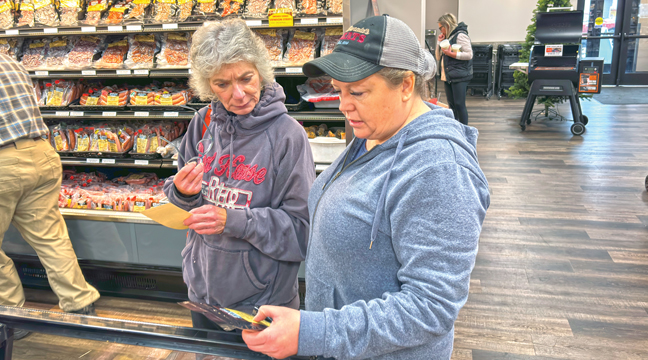The Sherburne History Center Winter Lecture Series opened this week with a program dealing with the Dakota Uprising, the fate of the Winnebago tribe and the formation of a secret society in Minnesota dedicated to the removal of all Indians from the territory.
Presenter Cathy Coats is a graduate student in public history at St. Cloud State University, and is currently researching the Winnebago tribe and the events surrounding the Dakota Uprising for her master’s thesis. Her lecture also dealt with the formation of a secret society known as the “Knights of the Forest” (KOTF) whose purpose was to ensure the removal or eradication of all Indians from the Minnesota territory in the aftermath of the Dakota War.
The story of the Winnebago tribe had attracted Coat’s interest, partially because so little of it is mentioned in the body of writings that were generated by the Dakota Uprising. The Winnebago were a small but independent tribe who were accomplished lead miners and traders who allied themselves with the French and later the British against the American and their constant pressure to take and settle Indian lands. Increasing pressure caused the Winnebago to move from their lands around Green Bay, WI between 1829 and 1840. The tribe was expelled from Wisconsin and placed on a reservation in Long Prairie, MN, in 1847, Coats said.
Long Prairie did not suit them well, since the site bordered Ojibwe land on the north and Dakota land on the south, both ancient enemies of the Winnebago. And, Coats said, white settlers remained hostile to the move, since the U.S. Government took land from them to form the reservation. The same took place in 1855, when eight Blue Earth County townships were converted into reservation land to house the Winnebago tribe, sparking mass protests from settlers who lost land there.
Failed crops and dishonest management by government agents led to the Dakota Uprising in 1859, with battles fought up and down the Minnesota River Valley and further north in the Red River Valley until the final Dakota defeat at the Battle of Wood Lake. At least 800 settlers were killed in the uprising, and 300 Dakota men were sentenced to death as a result. President Abraham Lincoln commuted all but 38 of the sentences, and those men were hanged in Mankato, MN on Dec. 26, 1862, the largest mass execution in U.S. history, Coats said.
On Jan. 1, 1863, the first meeting of the Knights of the Forest took place. The organization used the Masonic Lodge in Mankato as a headquarters, and used terms such as “Worthy Chancellor” for the supreme leader, whose identity has yet to be established. Group members identified themselves by a secret hand sign, Coats said, which was still in use among members a decade after the group had disbanded.
Members circulated petitions calling for the removal of all Indians from the territory, and threats of violence against the Blue Earth County reservation were ongoing during the time. Gov. Alexander Ramsey and other politicians wrote letters to Congress stating that they could not guarantee the safety of the Winnebago or Dakota, and they urged that the Indians be relocated “for their own safety.”
Congress ordered the removal of the Dakota to South Dakota in 1863, while the Winnebago were sent to a reservation in Omaha, NB. With no further purpose, the Knights of the Forest disbanded at that time. White settlers followed the pattern and flooded into the former Indian lands immediately after they had been vacated by the former owners. Hundreds of settler had signed to removal petitions, Coats said, but no official list of KOTF members has been uncovered to date.
The Winnebago tribe divided into two branches during this time of upheaval. Today, the older group is known as the Winnebago Tribe of Nebraska, and has technology and gaming interests in Iowa, Nebraska and Missouri. The other branch that remained in Wisconsin in defiance of the Federal relocation order is now known as the Ho-Chunk Nation. They also have gaming interests, including casinos in Madison, Wisconsin Dells, and other locations in the state. The population of both branches together is estimated to be around 12,000 people.
Future Lectures
The second lecture in the series will take place Tue., Jan. 20 at 2 p.m., with speaker Jeff Williams presenting a program on the Battle of Iwo Jima. On Feb. 3, Renae Elert will discuss the French Revolution, and Doug Breese will speak about the sinking of the RMS Titanic on Feb. 17, also at 2 p.m. The final lecture will be given by Ben Wood on Mar. 3 at 2 p.m., with a topic yet to be decided, according to SHC Program Coordinator Karah Hawkinson.








